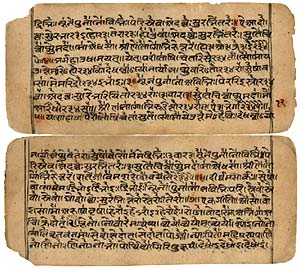Introduction to Scripture
Your unique soul-scriptures live at the heart of you, lying in wait for their opportunity to be humanifest. They may be covered in dust, they may be hidden from view, but they are still in there, sparkling with infinite possibility.
– Jeff Brown
 Scriptures are the texts which various religious traditions consider to be sacred. Many are believed to have been revealed by the Divine.
Scriptures are the texts which various religious traditions consider to be sacred. Many are believed to have been revealed by the Divine.
The scriptures are usually written in the form of sutra. A sutra is a short aphoristic statement in Sanskrit. They were a convenient way to transmit a teaching before the advent of printing. They could be committed to memory easily and would form the framework of future talks, and thus keep the teaching consistent. By its very nature, the sutra leaves much unsaid. The unexplained is to be taught by an enlightened Guru of a living tradition. A significant set of sutras generates many commentaries by later sages and scholars. This hints at a characteristic of the sutra form. They are not limiting pronouncements of dogma, but rather multivalent seeds of wisdom that are more fully revealed according to the understanding of the teacher.
There are two forms of Hindu Scriptures.
- Shruti – that which is revealed (Vedas, Upanishads)
- Smriti – that which is learned (Puranas)
The Sadhana of Studentship
In India, I would meet students so immersed in study and meditation. They would take a scripture like Tantraloka, Shiva Sutras, or Vigyan Bhairava, and then try deeply to search within themselves for the experience that it is teaching. It was interesting because you could spend hours on one verse, searching for the meaning, and when you find it, you would find yourself at rest within Consciousness, the mind will be stilling, and you would feel degrees of freedom or liberation. You would get an intensification of understanding and insight, not into just what was read, but into your whole life, into the nature of reality.
They would go on like this again and again throughout the day. This was their practice.